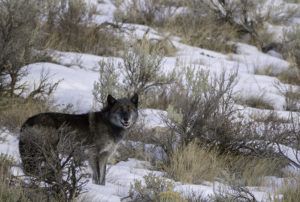Study: Montana, other states lack good data, fail to consider wolves value

A new study published in the journal Conservation Science and Practice suggests that while states like Montana and Idaho have adopted more aggressive wolf hunting strategies, neither the states nor the federal government have good, reliable and accessible data about wolf kills, livestock losses and other “nontarget species” that are captured in traps.
The study, “A new era of wolf management demands better data and a more inclusive process,” said that few states weigh the benefits of wolves as apex predators, instead only taking into account the drawbacks.
The primary authors, Peter Kareiva and Samantha Attwood, point out that verified and reliable data is often lacking in the conversation about wolves, and that without reliable information, wolf management is impossible.
Kareiva is the President and Chief Executive of the Aquarium of the Pacific in Long Beach, California while Attwood is the founding member of the Relist Wolves campaign, based in Seattle. They said that key data is often only obtainable by public information requests from the federal government, and other information on wolf hunting is only available through a patchwork of state reports. Even the USDA livestock losses report, which tracks how many kills are attributed to wolves, is reported only every five years.
In studies reported in 2015 and 2020, the USDA found that 3% of cattle and 10% of sheep were counted as “unwanted losses,” but the vast majority were due to “non-predator” causes like health problems, parasites, weather or birthing problems. The study points out that wolves only accounted for 0.21% for sheep and 0.05% for cattle.
“These minimal livestock losses attributed to wolves are even more noteworthy because they are likely overestimated,” the report said. “The USDA combines confirmed cases (kills) and ‘probable’ cases into one ‘loss’ figure, which will be biased upward unless every ‘probable’ kill is in fact caused by a wolf.”
The data also suggests that the USDA livestock loss estimates are based on mail surveys, but they are not confirmed by the department. Then, the numbers are extrapolated to get a statewide estimate.
The scientists looked at those reports compared to confirmed wolf kills by on-the-ground staff and noticed another important variance.
“This exercise revealed greater than a tenfold difference between livestock kills confirmed by state biologists and those extrapolated by the USDA from mailed surveys,” the article said.
The authors say that a lack of good data, coupled with the historical vilification of wolves, may result in policies and laws that aren’t rooted in science.
“Consider, for example, that in Idaho confirmed wolf kills have included livestock with no bite marks or injury under the assumption that ‘the cattle exert so much energy trying to escape wolves that they later die from the effort,’” the report said.
The scientists also question whether wolves are credited for killing animals that were instead killed by other predators. The report notes that United States Department of Agriculture experts in New Mexico and Montana often credited livestock kills to wolves almost as a “rubber stamp.”
“A USDA Wildlife Services district supervisor in Montana reports similar corruption in Montana due to the influence of the ranching lobby, stating, ‘We were the hired gun of the livestock industry,’” the study said.
Kareiva said that too often, the discussion around wolves has never considered the benefits of having them, and that problem is often compounded by no accessible data.
“You can’t have a discussion without data that is well understood and described,” he told the Daily Montanan during an interview. “We can’t have honest negotiations until we can also describe the benefits. Is a wolf worth more alive or dead? A lot of the conversation is that there are no benefits of wolves, so there is no hesitation to kill them. But as an ecologist, I am here to tell you: They have benefits.”
One of the other key points of the survey turns to wolf behavior, noting that gray wolves “prefer wild prey over domesticated livestock, and when they do attack livestock, prefer animals that graze freely in small numbers as opposed to larger or fenced herds.”
“There is little evidence to support the hypothesis that lethal wolf control is effective at reducing livestock losses,” the report said.
Wyoming wolf photo added by WU, shared by Wyoming photographer Tim Mayo.


